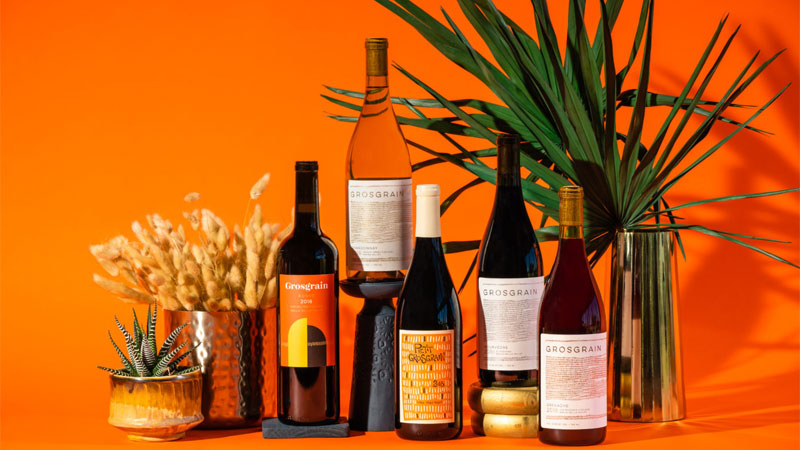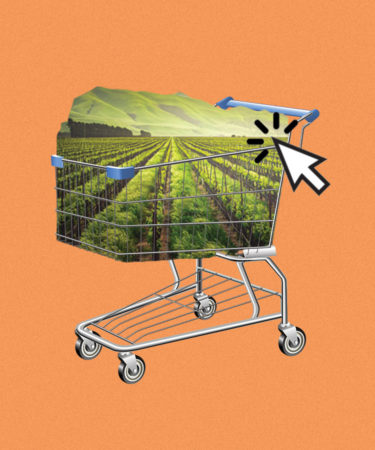Who hasn’t made a hasty purchase online? But the last time you clicked “Checkout,” a winery probably wasn’t in your cart. Kelly Austin, however, did score a winery on the internet. After winning an online auction in 2017, Kelly and her husband, Matt, were on the road to founding one of Walla Walla, Washington’s most unusually exciting and excitingly unusual new wineries: Grosgrain. From the labels outside to the wines within, each bottle tells a striking story.
Debuting with nary a Bordeaux grape but rather a fizzy duo of pét-nats among the roster of releases, it was clear from the start Grosgrain’s owners were going to do things a bit differently. The couple’s journey to winery ownership began in Los Angeles in 2004 on a first date, accompanied by a bottle of Pinot Noir. Gradually, their interest in wine grew, to the point where in 2014, Matt enrolled at the Northwest Wine Academy in Seattle, where Kelly’s family lives.
Officially, Kelly is the marketing director and Matt is the winemaker of Grosgrain, but like all small wineries, each founder does a bit of everything. Their lives as winery and vineyard owners are a far cry from their L.A. days, when Matt was an attorney in civil litigation and Kelly was a fashion designer. While Matt may have put his litigating days behind him, Kelly’s fashion background and creativity have been channeled into the winery’s name and stylish labels.
Don't Miss A Drop
Get the latest in beer, wine, and cocktail culture sent straight to your inbox.Grosgrain is a distinctive ribbon with a horizontal raised rib pattern, but the name is more than a nod to Kelly’s textile background. “It looks like a vineyard row when you see it from above,” she says, adding that the name ties her past career and current one together. When approaching the label design, she explains, she wanted to use a hand-drawn approach. “I do like vintage wood die cuts and vintage wood block printing,” she says. And though there are variations in the labels, Matt points out that they “try to incorporate that grosgrain pattern in at least some small way on every label.”
Forging a Path
Grosgrain’s labels caught the eye of Emily Riley, a partner at The Thief Fine Wine and Beer, a retail shop in downtown Walla Walla. “The big difference between selling wine from a restaurant list and selling wine from a shop,” says Riley, “is visual marketing.” She explains that people shopping at her store love labels. They love to look and touch, she says. “And people love the Grosgrain label. Kelly Austin did a bang-up job designing Grosgrain’s.”
Kelly also has an eye for collaborators. Her friend, Los Angeles-based artist Kimberly Bruckbauer, created the whimsical image for Grosgrain’s delicious Lemberger (yes, Lemberger) pét-nat. “The Blue Mountains [in the distance], the grain fields, and the old vines the grapes were picked from were all components that Kelly and Matt felt strongly about including in the design of the label,” Bruckbauer explains. “I imagined all of these elements together and created a dreamlike story where they all exist partying together.”
The Grosgrain Lemberger pét-nat pays homage to the historic Kiona vineyard, which was the first to be established on Red Mountain. The block where the Lemberger comes from was originally planted in 1976. California old-vine advocates like Carlisle Winery & Vineyards and Bedrock Wine Co. in Sonoma provided the inspiration for the wine; Matt would give it a Washington spin. “Lemberger,” he says, “really stood out to me as an opportunity to explore that heritage, with it being an important grape early on that’s fallen to the wayside — and a lot of the vines have been ripped out.”
JJ Williams, Kiona’s vineyard manager, has nothing but praise for the results. “To have Matt and Kelly come in with this vision, the ability and willingness to take the risk on a very nontraditional wine, and then to see it executed is just fantastic,” he says.
Envisioning a Sparkling Future
Lemberger isn’t Grosgrain’s only wine made from non-traditional grapes. The Austins cultivate an intriguing mix of varieties in the Old Milton vineyard adjacent to the winery. They are expanding plantings of Nebbiolo and Aglianico from the previous winery, and adding Grenache and Carignan. But the really exciting stuff is yet to come. The Grosgrain Vineyard on the Oregon side of Walla Walla Valley, part of the SeVein property, is going to be home to the grapes that are used to make Cava.
“With sparkling wine being a large part of our production,” says Matt, “we were thinking, what would be the best grapes to plant here for a sparkling program?” With the seasonal climate in Spain’s Cava region similar to that around Grosgrain’s vineyards, Matt settled on planting Macabeo and Xarel-lo, which will go into the ground in the spring. If those do well, Parellada may be next. “We’ve been drinking a lot of still wines of those [grapes], a lot of pét-nats of those, and obviously a lot of Cava,” Kelly says. The Austins have also been planting Vermentino and Ribolla Gialla, along with a quintet of red Rhône grapes — Syrah, Grenache, Mourvèdre, Cinsault, and Carignan.

But none of this is to say Grosgrain is only focused on the obscure and carving its own niche. Matt also takes inspiration from older bottlings from iconic regional producers like Leonetti Cellar and Woodward Canyon. Cabernet Sauvignon, Merlot, and Cabernet Franc were planted this year in Grosgrain Vineyard. He’s also reaching out to the people who made those and other standard-bearing Washington wines from Bordeaux grapes. Essentially, he says, he’s “trying to get advice from a lot of people here in town, what they’ve done historically, and have that inform some of the decisions we’re making.”
Kiona’s Williams recognizes that this can be a challenge for wineries. “I think it’s important for any winery to balance tradition with the unexpected,” he says. “It’s really difficult to win people over if you’re going full-on obscure, [but] if you go full-on traditional, that can be boring.” A winery needs the ability to “wrap people in a warm blanket of familiarity,” and then, once that comfort is achieved, “take them by the hand … into a new experience or philosophy.” And as Williams points out, Grosgrain can use its more familiar Chardonnay and Grenache wines to guide the way.
The Austins were certainly not risk-averse when it came to Grosgrain’s game plan. “What was kind of scary, was launching a line with mainly all whites,” Kelly says. “My dad was like, ‘Are you sure? You don’t have any big, bold reds.’” Ultimately, though, they stuck to their vision.
“We knew what we wanted to drink,” Kelly says. “Sometimes you just have to do it and not be scared.”
